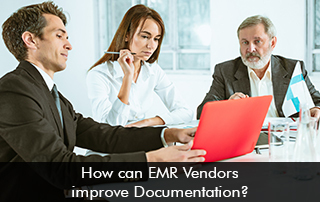Over the past few decades, Electronic Health Records software has greatly enhanced. The robust technology offers tools to streamline clinical, administrative, and financial tasks. However, some healthcare providers find it challenging to sort through information in the EMR software to make the correct clinical decisions.
EHR vendor’s efforts to simplify the clinical charting process
Health IT vendors have been working hard to reduce the documentation burden on clinicians by streamlining the overall charting process. They have added new features and NLP solutions to enable providers to finish documentation quickly and easily. Here are some of the ways EMR vendors can improve documentation:
- Implement voice recognition technology: Vendors of Electronic Medical Records (EMR) Software can incorporate voice recognition technology so that clinicians can dictate their notes and spend less time typing. In addition to increasing accuracy, this can lessen the requirement for manual documentation.
- Use natural language processing (NLP): NLP technology can assist clinicians in swiftly locating pertinent patient information within an EHR system. NLP can extract and organize patient data by utilizing machine learning algorithms to evaluate unstructured data. This allows physicians to spend less time searching for the information they need, hence streamlining clinical documentation.
- Streamline data entry: EMR providers can make data entry easier and more intuitive by removing additional fields and automating basic operations. This can cut down on the number of clicks and keystrokes needed to do a task, reducing the amount of time spent on documentation. This way, physicians can have more time to focus on their patients.
- Mobile accessibility: Mobile EHR software applications can allow clinicians to access patient information on the go. This reduces the need to document information later. A more effective workflow is achieved by enabling mobile access, which enables doctors to enter data while interacting with patients.
- Standardized documentation: Many electronic health records vendors such as Epic EMR Software, athenahealth, CareCloud, and ChartLogic have developed standardized documentation templates that are easy to use and understand by the user. By providing a consistent format, clinicians can document patient information in a breeze. Repetitive and unnecessary typing is eliminated.
Benefits of streamlined clinical documentation
Streamlined clinical documentation is bliss for providers as they don’t have to spend time on administrative tasks now. Once the documentation burdens are reduced, healthcare providers have the opportunity to offer high-quality patient care which can in turn boost patient outcome levels.
When clinical documentation is streamlined, there are fewer chances of any errors. As documentation is standardized clinicians may make fewer mistakes. This can lead to more accurate and complete patient records supporting the provider’s decision-making process at the point of care.
Major EHR Software vendors that offer voice recognition technology
The following EMR Software vendors offer voice recognition technology to ease the documentation and charting process.
- Epic Software offers Haiku.
- Cerner provides Voice Assistant.
- Allscripts Healthcare Solution has the Dragon Medical feature.
- athenahealth EMR software offers athenaClinicals Voice.
- NextGen Healthcare’s voice recognition tool is called NextGen Virtual Visit.
All these voice recognition tools allow clinicians to dictate notes and recognize different accents to speed up the tedious documentation process. As technology advances, more health IT vendors are anticipated to include speech recognition features in their software systems to lessen clinicians’ documentation load and improve workflow efficiencies.






